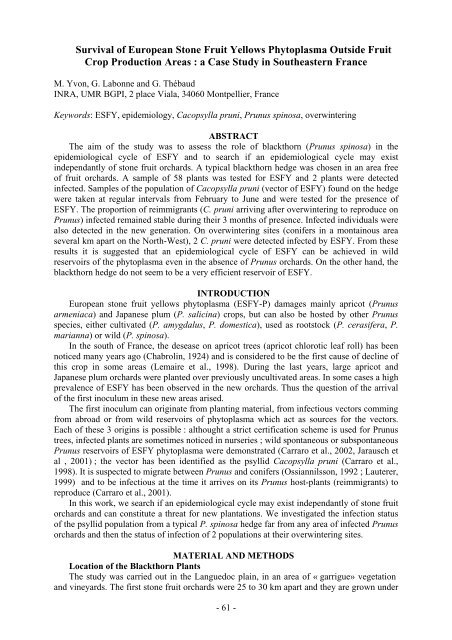Ecole Nationale Supérieure Agronomique de Montpellier ... - CIAM
Ecole Nationale Supérieure Agronomique de Montpellier ... - CIAM
Ecole Nationale Supérieure Agronomique de Montpellier ... - CIAM
You also want an ePaper? Increase the reach of your titles
YUMPU automatically turns print PDFs into web optimized ePapers that Google loves.
Survival of European Stone Fruit Yellows Phytoplasma Outsi<strong>de</strong> Fruit<br />
Crop Production Areas : a Case Study in Southeastern France<br />
M. Yvon, G. Labonne and G. Thébaud<br />
INRA, UMR BGPI, 2 place Viala, 34060 <strong>Montpellier</strong>, France<br />
Keywords: ESFY, epi<strong>de</strong>miology, Cacopsylla pruni, Prunus spinosa, overwintering<br />
ABSTRACT<br />
The aim of the study was to assess the role of blackthorn (Prunus spinosa) in the<br />
epi<strong>de</strong>miological cycle of ESFY and to search if an epi<strong>de</strong>miological cycle may exist<br />
in<strong>de</strong>pendantly of stone fruit orchards. A typical blackthorn hedge was chosen in an area free<br />
of fruit orchards. A sample of 58 plants was tested for ESFY and 2 plants were <strong>de</strong>tected<br />
infected. Samples of the population of Cacopsylla pruni (vector of ESFY) found on the hedge<br />
were taken at regular intervals from February to June and were tested for the presence of<br />
ESFY. The proportion of reimmigrants (C. pruni arriving after overwintering to reproduce on<br />
Prunus) infected remained stable during their 3 months of presence. Infected individuals were<br />
also <strong>de</strong>tected in the new generation. On overwintering sites (conifers in a montainous area<br />
several km apart on the North-West), 2 C. pruni were <strong>de</strong>tected infected by ESFY. From these<br />
results it is suggested that an epi<strong>de</strong>miological cycle of ESFY can be achieved in wild<br />
reservoirs of the phytoplasma even in the absence of Prunus orchards. On the other hand, the<br />
blackthorn hedge do not seem to be a very efficient reservoir of ESFY.<br />
INTRODUCTION<br />
European stone fruit yellows phytoplasma (ESFY-P) damages mainly apricot (Prunus<br />
armeniaca) and Japanese plum (P. salicina) crops, but can also be hosted by other Prunus<br />
species, either cultivated (P. amygdalus, P. domestica), used as rootstock (P. cerasifera, P.<br />
marianna) or wild (P. spinosa).<br />
In the south of France, the <strong>de</strong>sease on apricot trees (apricot chlorotic leaf roll) has been<br />
noticed many years ago (Chabrolin, 1924) and is consi<strong>de</strong>red to be the first cause of <strong>de</strong>cline of<br />
this crop in some areas (Lemaire et al., 1998). During the last years, large apricot and<br />
Japanese plum orchards were planted over previously uncultivated areas. In some cases a high<br />
prevalence of ESFY has been observed in the new orchards. Thus the question of the arrival<br />
of the first inoculum in these new areas arised.<br />
The first inoculum can originate from planting material, from infectious vectors comming<br />
from abroad or from wild reservoirs of phytoplasma which act as sources for the vectors.<br />
Each of these 3 origins is possible : althought a strict certification scheme is used for Prunus<br />
trees, infected plants are sometimes noticed in nurseries ; wild spontaneous or subspontaneous<br />
Prunus reservoirs of ESFY phytoplasma were <strong>de</strong>monstrated (Carraro et al., 2002, Jarausch et<br />
al , 2001) ; the vector has been i<strong>de</strong>ntified as the psyllid Cacopsylla pruni (Carraro et al.,<br />
1998). It is suspected to migrate between Prunus and conifers (Ossiannilsson, 1992 ; Lauterer,<br />
1999) and to be infectious at the time it arrives on its Prunus host-plants (reimmigrants) to<br />
reproduce (Carraro et al., 2001).<br />
In this work, we search if an epi<strong>de</strong>miological cycle may exist in<strong>de</strong>pendantly of stone fruit<br />
orchards and can constitute a threat for new plantations. We investigated the infection status<br />
of the psyllid population from a typical P. spinosa hedge far from any area of infected Prunus<br />
orchards and then the status of infection of 2 populations at their overwintering sites.<br />
MATERIAL AND METHODS<br />
Location of the Blackthorn Plants<br />
The study was carried out in the Languedoc plain, in an area of « garrigue» vegetation<br />
and vineyards. The first stone fruit orchards were 25 to 30 km apart and they are grown un<strong>de</strong>r<br />
- 61 -



